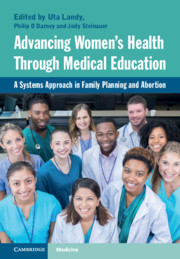 Advancing Women's Health Through Medical Education
Advancing Women's Health Through Medical Education Book contents
- Advancing Women’s Health Through Medical Education
- Reviews
- Advancing Women’s Health Through Medical Education
- Copyright page
- Dedication
- Contents
- Contributors
- Preface
- Acknowledgments
- Introduction
- Section I Abortion Training: Workforce, Leadership, Social & Political Impact
- Section II Integration of Abortion into Graduate Medical Education
- Section III Family Planning Curricular Design & Implementation
- Section IV Reproductive Health Services & Abortion Training: Global Examples
- Chapter 26 Sexual and Reproductive Health (SRH) Workforce
- Chapter 27 Medical Education for Safe Abortion Services in Nepal
- Chapter 28 Abortion Training and Integration in Ghana
- Chapter 29 Pre-service Integration of Abortion and Contraception Trainings in Ethiopia
- Chapter 30 Abortion Training and Integration into Clinical Practice in Colombia
- Chapter 31 Medical Education in Sexual and Reproductive Health in Uruguay
- Chapter 32 Abortion Training and Integration of Legal Services in the Public Health System of Mexico City
- Chapter 33 Abortion Training Models in Sweden
- Chapter 34 Abortion Training and Integration in the United Kingdom
- Chapter 35 Abortion Training and Integration in Ireland
- Index
- References
Chapter 34 - Abortion Training and Integration in the United Kingdom
from Section IV - Reproductive Health Services & Abortion Training: Global Examples
Published online by Cambridge University Press: 30 July 2021
- Advancing Women’s Health Through Medical Education
- Reviews
- Advancing Women’s Health Through Medical Education
- Copyright page
- Dedication
- Contents
- Contributors
- Preface
- Acknowledgments
- Introduction
- Section I Abortion Training: Workforce, Leadership, Social & Political Impact
- Section II Integration of Abortion into Graduate Medical Education
- Section III Family Planning Curricular Design & Implementation
- Section IV Reproductive Health Services & Abortion Training: Global Examples
- Chapter 26 Sexual and Reproductive Health (SRH) Workforce
- Chapter 27 Medical Education for Safe Abortion Services in Nepal
- Chapter 28 Abortion Training and Integration in Ghana
- Chapter 29 Pre-service Integration of Abortion and Contraception Trainings in Ethiopia
- Chapter 30 Abortion Training and Integration into Clinical Practice in Colombia
- Chapter 31 Medical Education in Sexual and Reproductive Health in Uruguay
- Chapter 32 Abortion Training and Integration of Legal Services in the Public Health System of Mexico City
- Chapter 33 Abortion Training Models in Sweden
- Chapter 34 Abortion Training and Integration in the United Kingdom
- Chapter 35 Abortion Training and Integration in Ireland
- Index
- References
Summary
Abortion has been legal in England, Scotland and Wales since 1967 when the Abortion Act was passed. The Act did not extend to Northern Ireland and abortion there has been highly restricted. Around 200,000 abortions are performed in Britain each year. In law, only doctors may authorize or perform abortions, but aspects of care can be delegated to other members of a healthcare team. Nearly three-quarters of abortions in the country are undertaken medically, a service mainly delivered by nurses and midwives. There are learning outcomes for abortion care in undergraduate medical education curricula and for post-graduate training in obstetrics and gynecology and community sexual and reproductive health care. However, a waning sense of responsibility by gynecologists to provide abortion care and, in England, a shift of abortion services away from National Health Service hospitals where training occurs to independent clinics, has resulted in fewer opportunities for practical exposure, role-modeling and mentorship. Formal education in abortion care for nurses and midwives is limited; most undertake professional development while working in an abortion service. Medical, nursing and midwifery colleges throughout the United Kingdom are actively working on improving the status of education in abortion care.
Keywords
- Type
- Chapter
- Information
- Advancing Women's Health Through Medical EducationA Systems Approach in Family Planning and Abortion, pp. 336 - 343Publisher: Cambridge University PressPrint publication year: 2021
